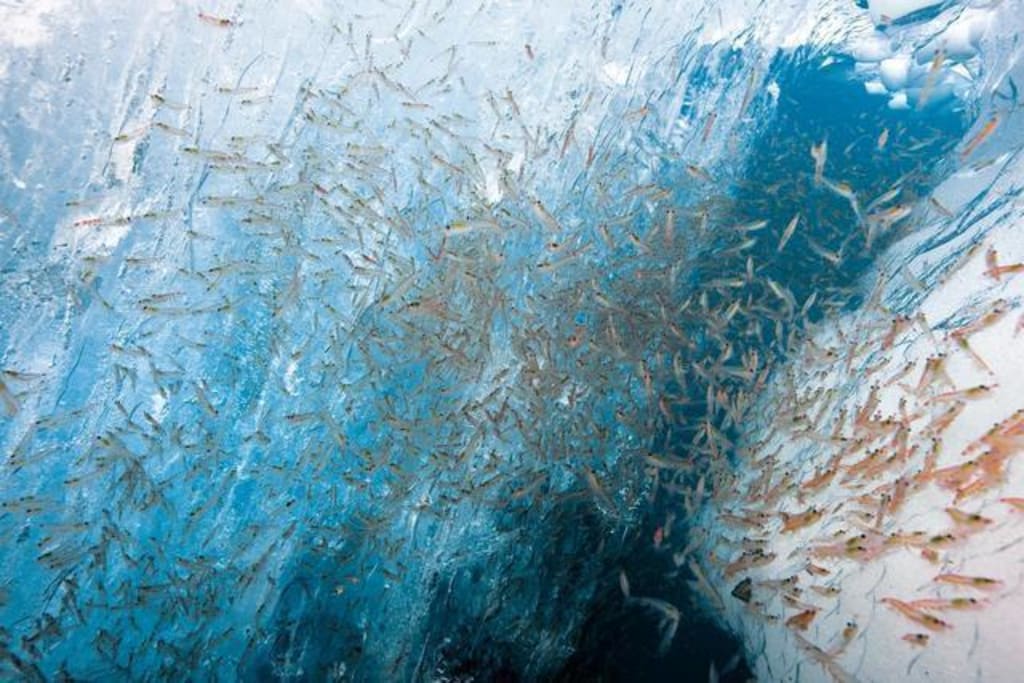Humans catch 300,000 tons of krill every year, will they eat up the krill?
Krill is called "sea pasture".

Krill is like a crop on the sea, and it can be caught a lot every year, and it does not require human maintenance at all.
Due to the large number of krill, there is now a common view that krill will never be fished by humans.
In fact, such a view is not very scientific. It can be clearly stated that the last animal that was thought to never be eaten was the passenger pigeon, but after the Europeans landed in North America, billions of passenger pigeons died in less than 100 years. There was not a single one left.
The population of krill is indeed huge, but they are not as tenacious as imagined. According to the British Guardian report, since the 1970s, the number of krill has decreased by about 80% in just 50 years [1], It can be described as a sharp decrease.
While this plummeting is thought to be largely caused by climate change, it is a fact that our catches have been increasing every year while krill populations have plummeted.
So, if nothing changes and the catch continues to increase, the krill will be "eaten up" sooner or later.
The reason for the huge number of krill populations is actually very simple - they are the consumers at the bottom of the marine food chain and can directly eat the most abundant plankton in the ocean.
How many krill are there in the ocean?
We do eat krill, but the krill and the shrimp skin we usually say are not from the same kind of shrimp, and there are very few krill directly eaten by us.
The small shrimps we usually eat are animals belonging to the genus Decapodidae (all kinds of shrimps we usually eat are basically decapods), which can be caught without going to the cold waters of Antarctica, and krill belongs to krill Shrimp.
There are many species of krill in the order Krill, and these shrimps have a common feature that they emit light, perhaps the name "krill" comes from this!
And the krill we usually refer to basically refer to Antarctic krill-they live in the Southern Ocean, which is one of the largest species on earth, and the shrimp we catch the most.
In 2009, a scientific team calculated that the biomass of Antarctic krill reached 0.05 gigatons of carbon (Gt C), which is similar to that of all humans today, but their body size is so small compared to humans, it is conceivable How large are their populations.
Counting the number of Antarctic krill is very difficult, so the error is often very large, and the data that can be found now shows that the maximum number of Antarctic krill may reach 6 billion tons.
During the breeding season, Antarctic krill can perform a very spectacular water show, with 10,000 to 60,000 individuals per cubic meter of water, dyeing the entire sea red, and satellites in space can capture such a scene.
Although there are indeed many Antarctic krill, the Antarctic krill directly eaten by humans is only a drop in the bucket, whether it is the part that is caught by humans or the part that is naturally depleted.
Antarctic krill is mainly used in aquaculture
Since 1972, when the value of Antarctic krill was discovered by the Soviet Union, the fishing of Antarctic krill has increased every year, and now about 150,000 to 300,000 tons of krill are caught every year worldwide, most of which are Antarctic krill.
Compared with the weight of 6 billion tons of Antarctic krill (the error of 6 billion tons is very large, some statistics show that it is only about 125 million tons), it seems that there is indeed very little part of human fishing.
The above photo is of two kinds of "shrimp skins" I took when I went to the supermarket to buy vegetables. I wonder if you can recognize which one is Antarctic krill?
The answer is: the red one on the right is Antarctic krill!
You will find that Antarctic krill is better than the shrimp skin on the left in terms of head size and color, but the price is only half of the ordinary shrimp skin.
In addition to the relatively large catch of krill, there is also the fact that it is not particularly popular. For me, I don’t like the taste of krill very much. It is much saltier than ordinary shrimp, so I rarely choose to buy Antarctic phosphorus. shrimp.
On the other hand, Antarctic krill is not particularly suitable for direct use as human food. Even if you buy it, it is not recommended to eat more. This is because their shells contain fluoride, which is toxic if ingested in high concentrations.
Therefore, the fished krill is not mainly for human consumption, it is mainly used as a protein supplement for the aquaculture industry, which is why krill is often referred to as "sea pasture".
However, krill oil, a processed krill product, has become very popular in recent years because it contains antioxidants such as astaxanthin, vitamins A and R, which are beneficial to the human body.
Therefore, the catch of krill has been increasing rapidly since 2010, with an annual increase of about 12%.
It can be seen that as long as we really want to eat them, it is still very terrible to consume.
Marine animals consume more krill than thought
In fact, compared to the part of krill that is naturally lost in the wild, the part caught by humans is also a drop in the bucket from the data point of view.
Because krill is the lowest consumer in the marine food chain, many marine animals and birds are based on krill, either eating krill directly or by eating krill-eating animals.
Those massive baleen whales are known to filter krill directly, with blue whales believed to consume 8,000 kilograms of krill a day.
But baleen whales are not yet the biggest consumers of krill. The animals that eat the most krill are seals and squid, because krill is the main food source for both animals, which are believed to each eat 100 million tons of krill each year. Krill.
All the animals on earth together may eat 313 million tons of Antarctic krill every year, and the part that humans catch (about 250,000 tons per year) is not worth mentioning in front of these animals.
Such data may be the reason why many people think that it is impossible for krill to be fished by humans.
However, people often overlook the damage to marine ecology when we fish, and the impact of global climate change caused by human activities on krill.
The Krill Paradox
There is a very famous paradox about Antarctic krill - the krill paradox, which refers to the fact that at a time when people were hunting for whales and the number of whales plummeted, people found that the number of krill was also decreasing.
It's a puzzling fact that whales eat krill, and when whales lose krill, they also decrease.
In fact, the reason is very simple. Whales have a wide range of food sources, and krill is just one of them, but the excrement of whales can affect the growth of plankton in the entire ocean.
With fewer whales, so did plankton, which meant that the krill would have less food to eat, and their numbers would naturally follow.
Passenger pigeons are indeed impossible to be eaten, and the step-by-step destruction of the habitat is the key to their extinction. For now, krill looks to be following suit.
at last
The number of living things is always limited, and people's desires are unlimited, so don't think that any animal can never be eaten, and you can catch it casually.
Antarctic krill populations are now declining much faster than thought, and the main reason is thought to be the accelerated melting of Antarctic glaciers.
Whatever the reason, if the krill is allowed to decline sharply, many animals will starve and their numbers will decrease, which is a terrible process.
About the Creator
Vicky
The world is so wonderful, let's get to know the world together!
Enjoyed the story? Support the Creator.
Subscribe for free to receive all their stories in your feed. You could also pledge your support or give them a one-off tip, letting them know you appreciate their work.






Comments
There are no comments for this story
Be the first to respond and start the conversation.